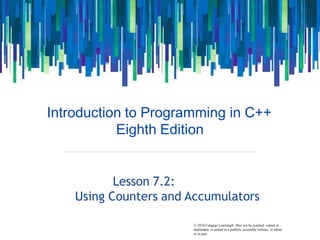
Lesson 7.2 using counters and accumulators
- 1. © 2016 Cengage Learning®. May not be scanned, copied or Introduction to Programming in C++ Eighth Edition Lesson 7.2: Using Counters and Accumulators duplicated, or posted to a publicly accessible website, in whole or in part.
- 2. • Someproblems require you to calculate atotal or average • Todo this, you use acounter, accumulator, or both • Acounter is anumeric variable used for counting something • An accumulator is anumeric variable used for accumulating (adding together) multiple values • Two tasks are associated with counters and accumulators: initializing andupdating © 2016 Cengage Learning®. May not be scanned, copied or duplicated, or posted to a publicly accessible website, in whole or in part. 2An Introduction to Programming with C++, Eighth Edition Using Counters and Accumulators
- 3. • Initializing means assigningabeginning value to a counter or accumulator (usually 0) – happensonce, before the loop isprocessed • Updating (or incrementing) means adding anumber to the value of acounter oraccumulator • Acounter is updated by aconstant value (usually1) • An accumulator is updated by avalue that varies • Update statements are placed in the body ofaloop since they must be performed at eachiteration © 2016 Cengage Learning®. May not be scanned, copied or duplicated, or posted to a publicly accessible website, in whole or in part. 3An Introduction to Programming with C++, Eighth Edition Using Counters and Accumulators (cont’d.)
- 4. Using Counters and Accumulators (cont’d.) Figure 7-13 Example of a partial game program that uses a counter © 2016 Cengage Learning®. May not be scanned, copied or duplicated, or posted to a publicly accessible website, in whole or in part. 4An Introduction to Programming with C++, Eighth Edition
- 5. Using Counters and Accumulators (cont’d.) Figure 7-14 Syntax and examples of update statements for counters and accumulators © 2016 Cengage Learning®. May not be scanned, copied or duplicated, or posted to a publicly accessible website, in whole or in part. 5An Introduction to Programming with C++, Eighth Edition
- 6. • Example problem and program solution (following slides) – Program takes in asequence of stock prices fromthe keyboard and outputs theiraverage – Usesacounter to keep track of the number of prices entered and an accumulator to keep track of the total – Both are initialized to 0 – Theloop endswhen the user enters asentinel value(-1) © 2016 Cengage Learning®. May not be scanned, copied or duplicated, or posted to a publicly accessible website, in whole or in part. 6An Introduction to Programming with C++, Eighth Edition The Stock Price Program
- 7. The Stock Price Program (cont’d.) Figure 7-15 Problem specification for the Sales Express program © 2016 Cengage Learning®. May not be scanned, copied or duplicated, or posted to a publicly accessible website, in whole or in part. 7An Introduction to Programming with C++, Eighth Edition
- 8. Figure 7-15 IPO chart information and C++ instructions for the Stock Price program The Stock Price Program (cont’d.) © 2016 Cengage Learning®. May not be scanned, copied or duplicated, or posted to a publicly accessible website, in whole or in part. 8An Introduction to Programming with C++, Eighth Edition
- 9. The Stock Price Program (cont’d.) Figure 7-16 Flowchart for the Stock Price program © 2016 Cengage Learning®. May not be scanned, copied or duplicated, or posted to a publicly accessible website, in whole or in part. 9An Introduction to Programming with C++, Eighth Edition
- 10. The Stock Price Program (cont’d.) Figure 7-17 Desk-check table after the first update to the counter and accumulator variables Figure 7-18 Desk-check table after the second update to the counter and accumulator variables © 2016 Cengage Learning®. May not be scanned, copied or duplicated, or posted to a publicly accessible website, in whole or in part. 10An Introduction to Programming with C++, Eighth Edition
- 11. The Stock Price Program (cont’d.) Figure 7-19 Completed desk-check table and sample runs for the Stock Price program © 2016 Cengage Learning®. May not be scanned, copied or duplicated, or posted to a publicly accessible website, in whole or in part. 11An Introduction to Programming with C++, Eighth Edition
- 12. • Loopscan be controlled using acounter rather thana sentinel value • Theseare called counter-controlled loops • Example problem and program solution (following slides) – Counter-controlled loop is used thattotals the quarterly salesfrom three regions – Looprepeats three times, once for eachregion, usinga counter to keeptrack © 2016 Cengage Learning®. May not be scanned, copied or duplicated, or posted to a publicly accessible website, in whole or in part. 12An Introduction to Programming with C++, Eighth Edition Counter-Controlled Pretest Loops
- 13. Counter-Controlled Pretest Loops (cont’d.) Figure 7-20 Problem specification, IPO chart information, and C++ instructions for the modified Stock Price program © 2016 Cengage Learning®. May not be scanned, copied or duplicated, or posted to a publicly accessible website, in whole or in part. 13An Introduction to Programming with C++, Eighth Edition
- 14. Counter-Controlled Pretest Loops (cont’d.) Figure 7-20 Problem specification, IPO chart information, and C++ instructions for the modified Stock Price program (cont’d.) © 2016 Cengage Learning®. May not be scanned, copied or duplicated, or posted to a publicly accessible website, in whole or in part. 14An Introduction to Programming with C++, Eighth Edition
- 15. Figure 7-21 Flowchart for the modified Stock Price program Counter-Controlled Pretest Loops (cont’d.) © 2016 Cengage Learning®. May not be scanned, copied or duplicated, or posted to a publicly accessible website, in whole or in part. 15An Introduction to Programming with C++, Eighth Edition
- 16. Figure 7-22 Completed desk-check table and sample run for the modified Stock Price program Counter-Controlled Pretest Loops (cont’d.) © 2016 Cengage Learning®. May not be scanned, copied or duplicated, or posted to a publicly accessible website, in whole or in part. 16An Introduction to Programming with C++, Eighth Edition